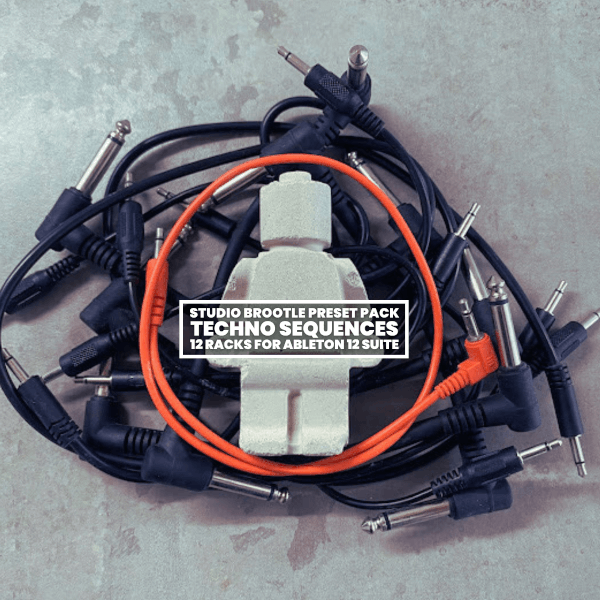Welcome to our guide to making techno sequences in Ableton Live. Using just stock instruments and effects units from Ableton Live 12 you can create brain-melting techno sequences.
We cover all you need to know to make ‘modular’ style techno sequences…
Buy our packs at our Shopify store, use this code for 25% off: SBCOM25STWD
Sign Up for free kick drums and sample packs each week by email:
Tips For Techno Sequences In Ableton Live
How to make techno sequences in Ableton Live, using Suite 12’s SQ Sequencer:
- Use an SQ Sequencer to pump out modulation
A sequencer is much better than drawing in midi for techno sequences. Just add a synth after it and you’re started. If you don’t have Ableton 12 Suite and the SQ sequencer, get any good Max for Live one. The best one I’ve found is the one that comes with Opal, but there are loads of good ones. They don’t need to be complicated, an acid style one is fine. Then add your best synth/plugin after it and start tweaking the patch…

- Add a synth and set up a detuned sound
I start with 3 oscillators all out of tune from each other as a good starting point. Operator or Wavetable work well with the Sequencers as they have good velocity modulation options.
- Shorten the loop for a rolling feel
Most sequences are 8 notes over half a bar or 16 notes for a full bar. You want to shorten the sequence length to 7,6,5, or even 3. And you get rolling polyrhythmic style sequences that sound great for techno.

- Use the velocity row like a second sequencer lane
With a hardware modular synth patch you’d take a second (or more) sequencer row and run a cable to somewhere else like the filter for more complex sequences. You can use the Velocity row of your sequencer for this: draw in different velocity values and then go to the synth and make Velocity modulate different parameters. This is really easy in Wavetable as you can add almost anything to the Velocity column on the mod matrix. I would start with filter Cutoff and make the sure it’s a low pass filter and it’s most of the way down. Now the filter can be sequenced and you can get really nice movement to the patch as the filter jumps about for each note.
- Make it short and gated
At least to begin with you want short, gated, almost percussive synth sounds, not long pads. So I do this with the filter envelope. I use a low pass filter set quite low to ‘hide’ the sound, but then use a really short decay filter envelope. This way so you get a quick plucky burst of synth for each note that pokes through the filter.
- Change the loop length of some rows for a ‘modular’ feel
You can add more modulation and movement by changing some sequencer row lengths and not others. For example if you make the Velocity row 7 steps in length and the Pitch row 5 they will run at different lengths and give the sequence that ‘modular’ feel. You can make it less random by doubling one, i.e. if the pitch is a 5 note sequence, make the velocity row 10 notes. You can also try doing this with a high value in the Octave row for a high pitch bleep every now and again.
- Modulate more things with Velocity
I like to vary the pitch envelope decay time for a really moving filter. And if I’m using Operator I modulate the pitch of the FM source too for some really alien sounding techno bleeps. You can use the Velocity column in Wavetable to modulate almost anything.

- Add more modulation with LFOs
You can add more modulation with LFOs too – square wave LFOs running at 1/8 or 1/16 lengths are similar to step sequences too.
- Tweak everything
Go back and tweak everything so all the modulations work together.
- Add a midi Chord unit
You can add a chord unit directly after the sequencer so that every note is converted into a Chord. Use a setting of 0,+3,+7 for a basic minor chord like you get in Detroit techno, or go off-piste with some nasty detuned chords like 0+,+1,+6. I do this a lot in my techno racks.

- Process it with effects
Process it with delay, reverb and eq. I like the Ableton Echo units. I use Drum Buss for distortion too.

- Add a sub bass layer
In Ableton, I group the synth patch after the sequencer and then add another synth chain under it playing a short, low sinewave sub bass patch. So you get a big sub bass under the sequence, playing the same notes.
- Record automation
Then record some automation. In Wavetable you have global Time and Amount controls to make all envelopes longer or shorter and the Amount increases or decreases all modulation amounts in one go. These are good starting points for what to automate, along with filter cut off. And you can create some nice builds by increase reverb time and delay feedback. In my racks I add these as Macros at the start so they can be tweaked and automated easily.
Buy Our Techno Sequences Pack For Ableton 12…
You can buy the techno sequences pack using the techniques mentioned above –> here.


